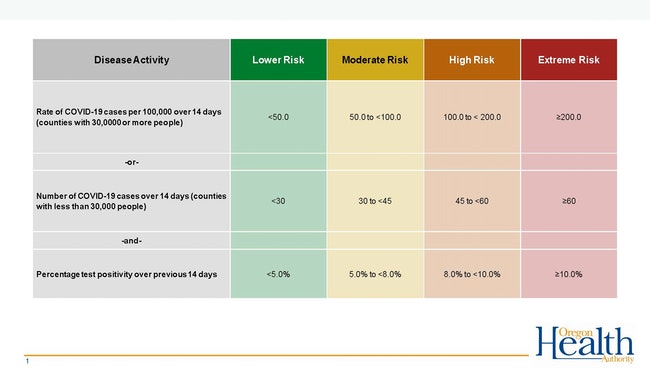 These are the factors that state officials will consider in assessing the risk and which restrictions will apply in Malheur County and other counties. The new framework was announced Wednesday by Gov. Kate Brown. (Oregon Health Authority graphic)
These are the factors that state officials will consider in assessing the risk and which restrictions will apply in Malheur County and other counties. The new framework was announced Wednesday by Gov. Kate Brown. (Oregon Health Authority graphic)
Malheur County will have to live under stringent limits on businesses and gatherings beyond next week as Gov. Kate Brown on Wednesday listed the county as facing “extreme risk” from the coronavirus pandemic.
The governor announced a new system for assessing the public health risk county by county, imposing limits that will ease as counties get the coronavirus under control.
For most of Oregon, though, the limits in place since last week will remain in effect, continuing to dampen the state’s economy as Oregonians head into the Christmas season.
Brown relented a bit on her restrictions on restaurants. She had limited restaurants and bars to takeout or delivery. Beginning Friday, Dec. 4, restaurants and bars statewide can host up to 50 people for outdoor dining – but with no more than six at a table.
For Malheur County and 20 other counties, the governor will continue to limit social gatherings to no more than six people, preferably from no more than two households.
Churches will be allowed to resume services, limited to 25% of a building’s capacity or 100 people indoors, whichever is smaller.
Brown is also encouraging retailers, grocers and pharmacies to switch to curbside pick-up for goods. They otherwise will have to limit people inside to 50% of a building’s capacity, usually defined by the square footage of the space.
The governor is giving counties an opening to live under fewer restrictions if they can bring down Covid cases and infection rates. The governor categorized counties by risk – extreme, high, moderate and low.
Indoor dining, for example, would be possible in counties rated at high risk or lower. Fifteen counties, mostly rural eastern Oregon locales, would be allowed to make that move at the end of next week.
“The framework is intended to establish sustainable protection measures for Oregonians in counties with rapid spread of Covid-19 while balancing the economic needs of families and businesses in the absence of a federal aid package,” Brown said in a prepared statement Wednesday afternoon.
The governor’s new measures for business and social gatherings closely follow those already being used by Oregon’s school districts to pick how local students can be educated. The key measures are the rate of Covid cases per 100,000 people and the percentage of Covid tests turning up positive – all over a 14-day period. The case rate will put most counties into the high risk category.
Based on the most recent data, Malheur County had 718 cases per 100,000 population – a formula used to treat all counties equally – and had a positive testing rate of 20%. Counties with a rate of 200 per 100,000 are in the high risk category and the benchmark positive testing rate to be considered high risk is 10%.
On Wednesday, Malheur County reported 2,358 Covid cases and a weekly positive testing rate of 32%.
So far, 38 deaths have been linked to Covid in the county.
Gov. Kate Brown issued the initial statewide pause Nov. 13 and it began Nov. 18.
The “pause” limited private social events to no more than six people and required bars and restaurants to offer only takeout service. Gyms and other venues – such as museums – were also closed as part of the statewide pause.
The new restrictions were slated to last at least two weeks.
At least initially it didn’t look like those restrictions otherwise would hit Malheur County business. That’s because local merchants were still allowed to open and required to ensure customers and workers wear masks and practice social distancing – steps most businesses are taking.
The initial state order limited retailers to no more than 75% of the people legally allowed in their business. Employers were also required to have employees work from home as much as possible and masking mandates inside the office.
Brown said she would direct police to enforce the new limits – including private gatherings – and under her order a violator can be charged with a misdemeanor punishable by up to 30 days in jail and a fine up to $1,250.
A joint statement released from the state’s law enforcement agencies, though, said police will focus on education – not enforcement – of the new restrictions.
This story will be updated following a news conference by the governor, scheduled for 2:30 p.m. MT Wednesday.




